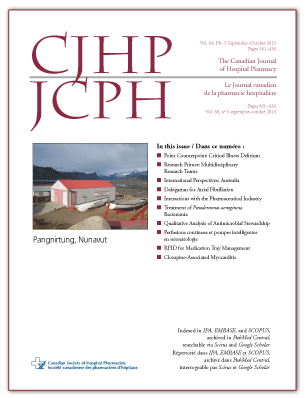Outcomes in Documented Pseudomonas aeruginosa Bacteremia Treated with Intermittent IV Infusion of Ceftazidime, Meropenem, or Piperacillin–Tazobactam: A Retrospective Study
DOI:
https://doi.org/10.4212/cjhp.v68i5.1485Keywords:
bacteremia, Pseudomonas, Pseudomonas aeruginosa, outcomes, ceftazidime, meropenem, piperacillin–tazobactam, intermittent infusion, infectious disease, bactériémie, Pseudomonas aeruginos, résultats, méropénem, pipéracilline-tazobAbstract
ABSTRACT
Background: Pseudomonas aeruginosa, one of the leading causes of nosocomial gram-negative bloodstream infections, is particularly difficult to treat because of its multiple resistance mechanisms combined with a lack of novel antipseudomonal antibiotics. Despite knowledge of timedependent killing with ß-lactam antibiotics, most hospitals in Canada currently administer ß-lactam antibiotics by intermittent rather than extended infusions.
Objectives: To determine clinical outcomes, microbiological outcomes, total hospital costs, and infection-related costs for patients with P. aeruginosa bacteremia who received intermittent IV administration of antipseudomonal ß-lactam antibiotics in a tertiary care institution.
Methods: For this retrospective descriptive study, data were collected for patients who were admitted between March 1, 2005, and March 31, 2013, who had P. aeruginosa bacteremia during their admission, and who received at least 72 h of treatment with ceftazidime, meropenem, or piperacillin–tazobactam. Clinical and microbiological outcomes were determined, and total and infection-related hospital costs were calculated.
Results: A total of 103 patients were included in the analysis, of whom 79 (77%) experienced clinical cure. In addition, bacterial eradication was achieved in 41 (87%) of the 47 patients with evaluable data for this outcome. Twenty-eight (27%) of the 103 patients died within 30 days of discontinuation of antipseudomonal ß-lactam antibiotic therapy. The median total cost of the hospital stay was $121 718, and the median infection-related cost was $29 697.
Conclusions: P. aeruginosa bacteremia is a clinically significant nosocomial infection that continues to cause considerable mortality and health care costs. To the authors’ knowledge, no previous studies have calculated total and infection-related hospital costs for treatment of P. aeruginosa bacteremia with intermittent infusion of antipseudomonal ß-lactam antibiotics, with characterization of cost according to site of acquisition of the infection. This study may provide important baseline data for assessing the impact of implementing extended-infusion ß-lactam therapy, antimicrobial stewardship, and infection control strategies targeting P. aeruginosa infection in hospitalized patients.
RÉSUMÉ
Contexte : La bactérie Pseudomonas aeruginosa, l’une des principals causes des bactériémies nosocomiales à ram négatif, est particulièrement difficile à traiter, parce qu’elle possède de nombreux mécanismes de résistance et qu’il n’y a pas de nouveaux antibiotiques anti-Pseudomonas. Bien que l’on sache que l’effet bactéricide des ß-lactamines est fonction du temps, la plupart des hôpitaux au Canada administrent actuellement ces antibiotiques par perfusions intermittentes plutôt que prolongées.
Objectifs : Déterminer quels sont les résultats cliniques, les résultats microbiologiques, les coûts totaux d’hospitalisation et ceux liés à l’infection seule pour les patients atteints d’une bactériémie à P. aeruginosa ayant reçudes ß-lactamines anti-Pseudomonas par perfusion intermittente dans un établissement de soins tertiaires.
Méthodes : Pour la présente étude rétrospective descriptive, on a recueilli des données sur des patients hospitalisés entre le 1er mars 2005 et le 31 mars 2013, qui étaient atteints d’une bactériémie à Pseudomonas aeruginosa, et qui ont reçu au moins 72 heures de traitements par ceftazidime, méropenem ou pipéracilline-tazobactam. Les résultats cliniques et microbiologiques ont été déterminés, et les coûts totaux d’hospitalisation et ceux liés à l’infection ont été calculés.
Résultats : En tout, 103 patients ont été retenus pour l’analyse. Parmi eux, 79 (77 %) ont joui d’une guérison clinique. De plus, une eradication bactérienne a été obtenue chez 41 (87 %) des 47 patients ayant des données évaluables pour ce résultat. Vingt-huit (27 %) des 103 patients sont décédés dans les trente jours suivant la fin de l’antibiothérapie par ß-lactamines anti-Pseudomonas. Le coût total médian du séjour à l’hôpital était de 121 718 $ et le coût médian lié à l’infection était de 29 697 $.
Conclusions : La bactériémie à Pseudomonas aeruginosa est une infection nosocomiale cliniquement significative. Elle demeure à ce jour une cause importante de mortalité et une source considérable de coûts de soins de santé. À la connaissance des auteurs, aucune étude antérieure n’a calculé les coûts totaux d’hospitalisation et ceux liés à l’infection pour le traitement de la bactériémie à Pseudomonas aeruginosa par perfusion intermittente de ß-lactamines anti-Pseudomonas, en caractérisant ces coûts selon le site de transmission de l’infection. Cette étude pourrait fournir d’importantes données de référence pour évaluer l’effet de la mise en place du traitement par perfusion prolongée de ß-lactamines, d’une gestion responsable des antimicrobiens et de stratégies de prévention des infections qui visent l’infection à P. aeruginosa chez les patients hospitalisés.
Downloads
Published
Issue
Section
License
Copyright © Canadian Society of Healthcare-Systems Pharmacy.
After publication of a manuscript in the CJHP, the authors of the manuscript must obtain written permission from the CSHP (publications@cshp.ca) before reproducing any text, figures, tables, or illustrations from the work in future works of their own. If a submitted manuscript is declined for publication in the CJHP, all said rights shall revert to the authors. Please note that any forms (e.g., preprinted orders and patient intake forms) used by a specific hospital or other health care facility and included as illustrative material with a manuscript are exempt from this copyright transfer. The CJHP will require a letter from the hospital or health care facility granting permission to publish the document(s).










